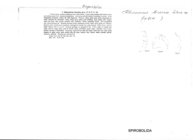MilliBase
Traits name details
Rhinocricus bicornis Silvestri, 1897
950359 (urn:lsid:marinespecies.org:taxname:950359)
uncertain
Species
Proporobolus bicornis (Silvestri, 1897) · unaccepted
Silvestri, F. (1897). Neue Diplopoden. <em>Abhandlungen und Berichte des Königl. Zoologischen und Anthropologisch-Ethnographischen Museums zu Dresden.</em> 6(9): 1-23. Dresden.
page(s): 5 [details]
page(s): 5 [details]
Sierwald, P.; Decker, P.; Spelda, J. (2025). MilliBase. Rhinocricus bicornis Silvestri, 1897. Accessed through: Marine Species Traits editorial board (2025) Marine Species Traits at: https://www.marinespecies.org/traits/aphia.php?p=taxdetails&id=950359 on 2025-04-04
Marine Species Traits editorial board (2025). Marine Species Traits. Rhinocricus bicornis Silvestri, 1897. Accessed at: https://www.marinespecies.org/traits/aphia.php?p=taxdetails&id=950359 on 2025-04-04
original description
Silvestri, F. (1897). Neue Diplopoden. <em>Abhandlungen und Berichte des Königl. Zoologischen und Anthropologisch-Ethnographischen Museums zu Dresden.</em> 6(9): 1-23. Dresden.
page(s): 5 [details]
additional source Attems, C. M. T. Graf von. (1914). Die indo-australischen Myriopoden. <em>Archiv für Naturgeschichte.</em> 80A(4): 1-398. Berlin., available online at https://www.biodiversitylibrary.org/page/13260451
page(s): 308 [details]
source of synonymy Marek, P. E.; Bond, J. E.; Sierwald, P. (2003). Rhinocricidae systematics II: a species catalog of the Rhinocricidae (Diplopoda: Spirobolida) with synonymies. Zootaxa, 308: 1-108. Auckland
page(s): 45 [details]
new combination reference Chamberlin, R. V. (1920). The Myriopoda of the Australian Region. <em>Bulletin of the Museum of Comparative Zoology.</em> 64(1): 1-269., available online at https://biodiversitylibrary.org/page/30743608
page(s): 176; note: Proporobolus bicornis [details]
status source Jeekel, C. A. W. (2001). A bibliographic catalogue of the Spirobolida of the Oriental and Australian regions (Diplopoda). Myriapod memoranda, 4: 5-104. Oisterwijk
page(s): 39; note: RHINOCRICIDAE of uncertain generic position. The posterior gonopod of this species as illustrated by Silvestri somewhat suggests an American or perhaps an Australian rhinocricid. Considering what is...
[details]
page(s): 5 [details]
additional source Attems, C. M. T. Graf von. (1914). Die indo-australischen Myriopoden. <em>Archiv für Naturgeschichte.</em> 80A(4): 1-398. Berlin., available online at https://www.biodiversitylibrary.org/page/13260451
page(s): 308 [details]
source of synonymy Marek, P. E.; Bond, J. E.; Sierwald, P. (2003). Rhinocricidae systematics II: a species catalog of the Rhinocricidae (Diplopoda: Spirobolida) with synonymies. Zootaxa, 308: 1-108. Auckland
page(s): 45 [details]
new combination reference Chamberlin, R. V. (1920). The Myriopoda of the Australian Region. <em>Bulletin of the Museum of Comparative Zoology.</em> 64(1): 1-269., available online at https://biodiversitylibrary.org/page/30743608
page(s): 176; note: Proporobolus bicornis [details]
status source Jeekel, C. A. W. (2001). A bibliographic catalogue of the Spirobolida of the Oriental and Australian regions (Diplopoda). Myriapod memoranda, 4: 5-104. Oisterwijk
page(s): 39; note: RHINOCRICIDAE of uncertain generic position. The posterior gonopod of this species as illustrated by Silvestri somewhat suggests an American or perhaps an Australian rhinocricid. Considering what is...
RHINOCRICIDAE of uncertain generic position. The posterior gonopod of this species as illustrated by
Silvestri somewhat suggests an American or perhaps an Australian
rhinocricid. Considering what is known of the Rhinocricidae
occurring on the Fiji Islands, they all belong to the genus
Dinelllatocricus in the sense of this catalogue, and not to Proporobolus.
Maybe the locality label of the material was incorrect.
From editor or global species database
Image from synonym
